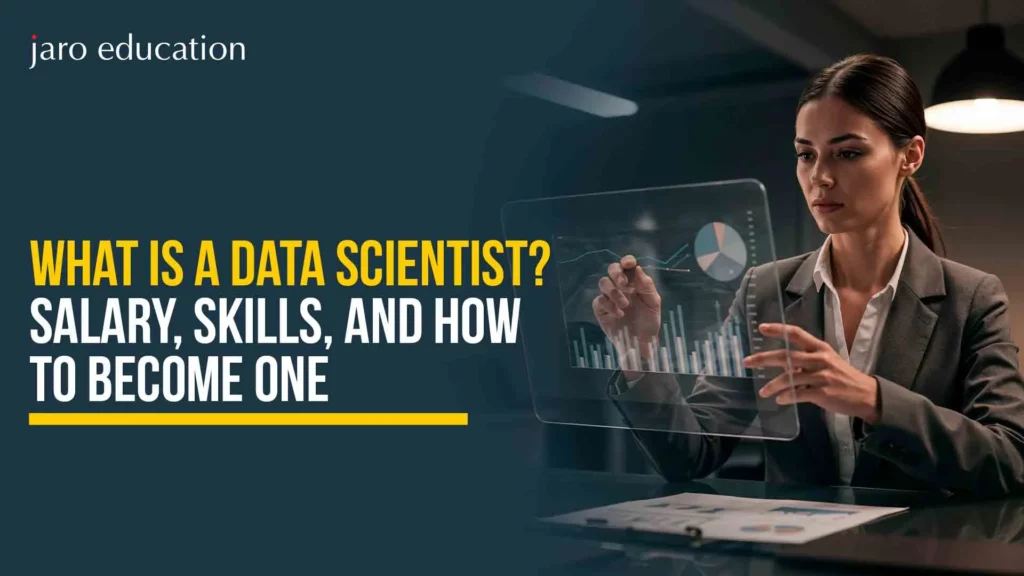Binary Search Algorithm: Benefits, and Examples
Table of Contents

- jaro Education
- 16, August 2023
- 3:00 pm
A search algorithm for finding the position of a target value in a sorted array, a binary search (or half-interval search, logarithmic search, and binary chop) compares the target value to the middle element of the array. When they are not equal, the half in which the target cannot lie is eliminated, and the search continues on the remaining half, again taking the middle element to compare with the target value and repeating the process until the target value is found. The remaining half of the array will contain no elements if the search ends. Thus, in this case, the target is not in the array.
Suppose one has ever searched for a name in a phone book or sought a word in a dictionary. In that case, such a person has used binary search even without realizing it.
In this post, you will discover
- What is a binary search?
- How the binary search algorithm works
- The time complexity of the binary search
- Real-world binary search examples
- Interactive code and use cases
- Advantages of binary search over other search methods
What is a Binary Search Algorithm?
In every computational system, developing search functionalities is a critical aspect. From retrieving files to indexing, search techniques are used in many applications. The binary search technique is one of the search techniques commonly used for computation. It is one of the vital algorithms crucial for reducing computational complexity. The search algorithm is popularly used for effectively searching elements in sorted data structures.
The binary search algorithm systematically divides a search space in half on each iteration. It rapidly narrows down the possibilities, leading to prompt and reliable outcomes. This algorithm serves as an upgraded alternative to the much simpler linear search algorithm.
Working Principle of the Binary Search Algorithm
The binary search algorithm is generally used to operate on a sorted array of lists. By following a divide-and-conquer approach, it efficiently locates a target element within a provided collection. The algorithm collates the target element with the middle element of the array and recursively narrows down the search range based on the comparison result.
The predominantly used first step in the binary search algorithm is sorting the list. When sorting is done, it’s time to search for the median from the given list as per the value desired.
- If your desired value is worth the central index, then this value is returned as the answer.
- But if the target value is less than the central index, the list’s right side is ignored.
- The left half is rejected when the value desired is larger than the value of the central index.
- The shortlist repeatedly goes through this process until the target value is formed.
Binary Search Example:
Situation 1:
To understand better, let us cite a binary search example. Consider the following set of numbers:
3, 17, 25, 5, 6, 12, 19, 1, 29
Suppose our desired value is 29, and the list has a total of 9 elements.
Our initial step should be to sort this list. Post sorting, you will find this list to look as follows:
1, 3, 5, 6, 12, 17, 19, 25, 29
As this list has 9 elements in total, the central index will be at the 5th position. Here, you can find the central index to be 12. On the other hand, our desired value is 29, which is compared with the central index of 12.
It is clear that 12 is smaller than 29, so the left part of the list should be ignored. We can only navigate through the right side of the list. So the new list will be:
17, 19, 25, 29
Note:
In regular practice, the list is not shortened. The focus shifts to specific observations. Thus, the “new list” is not just shortening the existing list or creating a new list. Even though it can be used with a new list, two varied problems may arise.
- Firstly, memory overhead can take place. With every new list, the space complexity keeps increasing.
- Secondly, tracking the original indices is needed for every iteration.
When the new index is found, it is considered either the second or the third element. This depends on the way of implementation. The value 25 can be compared with the value desired, that is, 29. This is so because this value is more than the central index. The system discards the left half of the list because the value 23 exceeds the central index. Now the list to navigate through has one element, which is 29. As the list has only one element, it is now the central element. The desired value is compared with 29. As the two values match, 29 is returned as the index value of the actual or original list.
Situation 2:
If we have 2 as the desired value in the same list we were discussing, then the central index 12 is first compared with 2. Since 12, the central index, is greater than the desired value of 2, we must focus on the left side of the list.
The new list will have:- 1, 3, 5, 6
Consider the middle or central element as our second element, and compare the desired value of 2 with 3. As we know, 3 is greater than 2, so we will again consider the left-hand side of the list. The new list now contains only element 1. This value will again be compared with the other elements. The context reveals that the values do not match. So, breaking out of the loop is the only option, which is denoted by an error text written as “value not found.”
Time Complexity Analysis of the Binary Search Algorithm
The time complexity of an algorithm is the total time it takes to run as a function of the input size. Analyzing the time complexity of an algorithm helps us understand how its performance scales with larger inputs. In the case of the binary search algorithm, its time complexity is determined by the number of iterations required to find the target element.

*Jaro Education
The binary search algorithm employs a strategy of division and conquering. It repeatedly divides the search range in half until the target element is found or the search range becomes empty. This logarithmic behavior gives the binary search algorithm its efficient time complexity.
To understand the time complexity of binary search algorithms in detail, follow the segment below.
Time Complexity Overview
| Case | Time Complexity |
|---|---|
| Best Case | O(1) |
| Average Case | O(log n) |
| Worst Case | O(log n) |
Explanation
Best Case: O(1)
The target element is located exactly in the middle of the array in the first comparison.
Only one comparison is needed.
Average Case: O(log n)
On average, binary search will need to split the array log₂(n) times before finding the element.
For example, in a list of 1024 elements, it would take around log₂(1024) = 10 comparisons.
Worst Case: O(log n)
The element either doesn’t exist or is at the very end of the list.
Even in the worst case, binary search remains efficient due to halving the search space with each iteration.
Why O(log n)?
Binary search cuts the problem size in half each time.
Start with n elements
After 1 step → n/2
After 2 steps → n/4
After k steps → n / 2^k = 1
Solving for k gives:
k = log₂(n)
That’s why the time complexity is O(log n).
The first step includes dividing the search range in half. So, the maximum number of iterations required to find the target element is equal to the number of times the search range can be divided in half.
For instance, if your array size is 1000, it can take a maximum of 10 iterations to find the target element. On the other hand, if you have an array size of 1,000,000, it can take a maximum of 20 iterations.
When you compare this approach with linear search, where the time complexity is O(n) and n denotes the array size, the binary search algorithm shows notable improvement in terms of time efficiency. In the worst-case scenario, a linear search may need to scan the entire array; on the contrary, a binary search eliminates half of the remaining elements in every step.
It is critical to understand that the binary search algorithm considers the input array as already sorted. If the array is not sorted, an extra step for sorting the array is necessary. This step increases the overall time and space complexity of the binary search.
Space Complexity Analysis of the Binary Search Algorithm
To understand the complexity of the binary search algorithm, it is important to consider space complexity along with time complexity. Space complexity denotes the space or memory required by an algorithm to execute as a function of the input size. Assessing an algorithm’s scalability and memory requirements. In the case of the binary search algorithm, the space complexity is primarily determined by the recursive calls and any additional data structures used.
You can utilize binary search space complexity in multiple ways, which are a matter of discussion in this section.
- Recursive Call Method
You can implement the binary search algorithm by using recursion. Every recursive call creates a new stack frame. These stack frames have variables, return addresses, and various other information. The number of recursive calls depends on the depth of the binary search tree. It is determined by the number of iterations required to find the target element. Hence, it can be said that the space complexity of the binary search algorithm using the recursive method is proportional to the depth of the binary search tree.
- Iterative Method
One can iteratively implement a binary search algorithm using loops. In such cases, there are no recursive calls. Besides, the space complexity is constant, irrespective of the input size. Only a few variables are required to keep track of the lower and upper bounds and the middle index during each iteration. Therefore, the space complexity of the iterative implementation of the binary search algorithm is O(1).
- Exceptional Case of Additional Data Structures
The binary search algorithm does not itself require any additional data structures, excluding the input list or array. But if the algorithm includes added data structures like auxiliary arrays, queues, or trees, their space requirements should also be considered. For instance, if an additional list is used to store intermediate results or to help in the process of search, the space complexity would depend on the list size.
Advantages and Disadvantages of Binary Search
Advantages
The use of a binary search algorithm is vast due to its high efficiency in locating target elements in sorted lists. Here are the prime advantages of this algorithm that users can witness.
| Easy to Implement | The binary search algorithm is relatively simple to implement. Both recursive and iterative methods work well, depending on the programming languages and preferences. The simplicity of the algorithm and its well-defined steps make it accessible to programmers of different skill levels. |
| Makes Search Space Half | As binary search operates by continuously dividing the search space in half, it eliminates a large portion of the remaining elements in every step. This property makes binary search highly efficient, especially for large datasets. By halving the search space in each iteration, binary search narrows down the possibilities quickly, making it an optimal choice for sorted arrays or lists. |
| Enhanced Time Complexity | The binary search algorithm has a time complexity of O(log n); here, n is the size of the input. This logarithmic time complexity makes binary search significantly faster than linear search, which has a time complexity of O(n). As the size of the input increases, binary search requires fewer iterations to find the target element, resulting in enhanced performance. |
| Wide Application | You can use binary search for many purposes, along with searching for specific elements from collections. From finding an element’s position to determining the presence of a value in a sorted list, binary search can be used in many ways. It is a fundamental building block in other advanced algorithms and techniques, including binary search trees. |
Disadvantages
While the binary search algorithm’s advantages are many, there are a few limitations that should be noted while using the same.
| Necessity of a Sorted List | Binary search requires the sorted data to be in ascending or descending order. If the data is not pre-sorted, additional preprocessing steps are necessary. This can increase the overall time complexity of the algorithm. With that, this requirement may not always be feasible, especially in scenarios where the data is frequently changing or dynamically updated. |
| Memory Overhead | Binary search, particularly when implemented recursively, relies on the use of stack frames to store information about each recursive call. This can lead to a significant memory overhead, especially when dealing with a large number of elements or a deep recursion stack. In cases where memory is limited, the memory requirements of the binary search may be a concern. |
| Time-Taking Sorting for Small Lists | When there are small unsorted lists, binary search takes a considerable time to sort them. Then it furthers the search process for the desired value. So, in most cases of small unsorted lists, the use of the binary search algorithm is avoided. |
Best Practices and Tips for Utilising Binary Search Effectively
The use case of the binary search algorithm is not limited to just sorting arrays of lists. Below are two distinct patterns that can help solve problems related to binary search in almost 90% of cases.
Separating Condition
In this approach, you can use a variation of binary search to find the first occurrence of a specific element in an array, given a clear property that separates the right and left halves of the list or array around the target answer.
For instance, consider an array that contains some elements of value 2. This is followed by a few elements of 0, and there are also a few elements with value 1. It looks like (2,2,0,0,0,1,1).
By observing the array, we notice that everything to the left of the first occurrence of 1 consists of elements that are either 2 or 0, while everything to the right is 1. This property serves as the separation criterion for your search.
During the binary search, the element at the middle index, arr[mid], is checked. If arr[mid] is equal to 2 or 0, we know that the desired value lies on the right side of the array because the separating condition is not satisfied. Therefore, we update the lower bound by setting ‘low’ to mid + 1. Conversely, if arr[mid] is equal to 1, we have encountered the first occurrence of the desired value. However, to ensure that we find the actual first occurrence, we continue searching on the left side. Therefore, we update the upper bound by setting ‘high’ to mid-1.
Monotonic Relation
When there is a scenario where you observe a consistent relationship between two variables and aim to determine the minimum or maximum value of one variable while adhering to a constraint on the second variable, a binary search approach can be employed.
For instance, if you want to find the smallest number whose cube exceeds 999, you can use binary search as follows:
Here, you have two variables, x and y = x³, which showcase a monotonic relationship (i.e., an increase in x leads to an increase in y). Rather than employing a linear search by calculating and comparing cubes (1³, 2³, 3³, and so forth), we can leverage binary search within a certain range. By examining the midpoint value, we calculate its cube. You must update the upper bound and modify your search to lower values if it surpasses 999. On the other hand, if the cube is less than 999, you should search for larger values (updating the lower bound).
Comparison with Other Search Algorithms
Binary Search Vs Linear Search
Linear search and binary search are two common algorithms used to find an element in a list. The linear search checks each element sequentially until the target is found or the end of the list is reached. It is simple but inefficient for large lists. On the other hand, binary search is a more efficient algorithm that works on sorted lists. It repeatedly divides the search space in half, comparing the target with the middle element and discarding the irrelevant half.
Binary Search Vs Hashing
Binary search and hashing are two different techniques used for searching in data structures. The binary search is efficient for sorted arrays and offers logarithmic time complexity, while hashing provides constant-time complexity for retrieval but requires additional memory for hash tables and hashing functions.
Conclusion
The binary search algorithm is a potent tool that offers numerous benefits in terms of efficiency. By leveraging the inherent properties of sorted data, binary search allows for a significant reduction in the number of comparisons required to find a target element. This advantage makes it a preferred choice for searching large datasets, particularly in computer science and information retrieval applications.
Frequently Asked Questions
Binary search is an efficient search algorithm that finds the position of a target value within a sorted list by repeatedly dividing the search range in half.
Binary search starts by comparing the target value to the middle element of the sorted array:
- If equal, it returns the index.
- If the target is smaller, it searches the left half.
- If larger, it searches the right half. This continues until the value is found or the search space is empty.
Best Case: O(1) (when the target is in the middle)
Average Case: O(log n)
Worst Case: O(log n)
Binary search is faster than linear search (O(n)) for large sorted datasets.
No, binary search only works on sorted arrays or lists. If the data is unsorted, it must be sorted first (which takes additional time).
- Much faster than linear search for large datasets
- Reduces the number of comparisons
- Efficient for static sorted data
- Low memory usage with the iterative version









